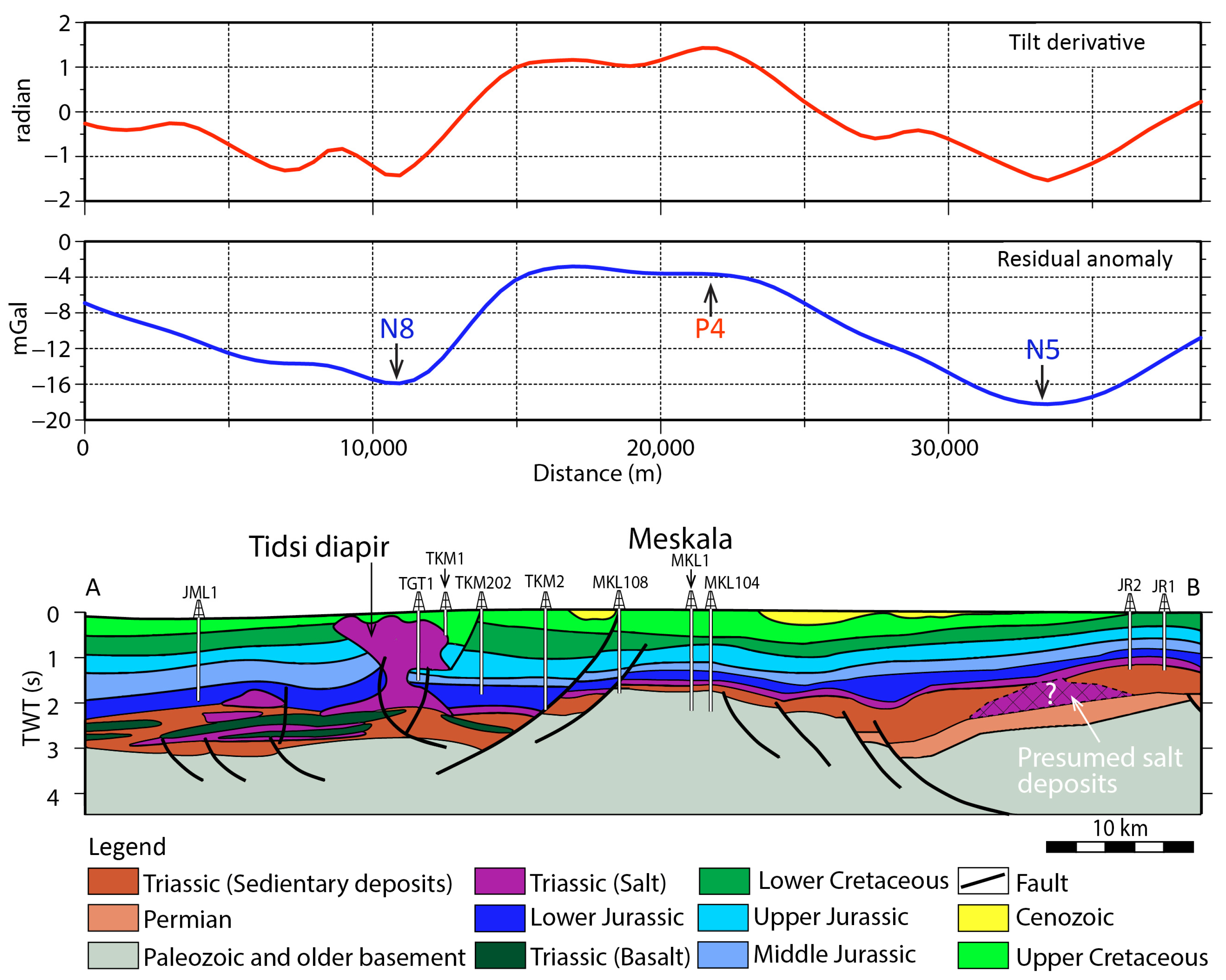Understanding the Deep Structure of the Essaouira Basin Using Gravity Data: Hydrogeological Inferences for a Semiarid Region in Central-Western Morocco
Abstract
:1. Introduction
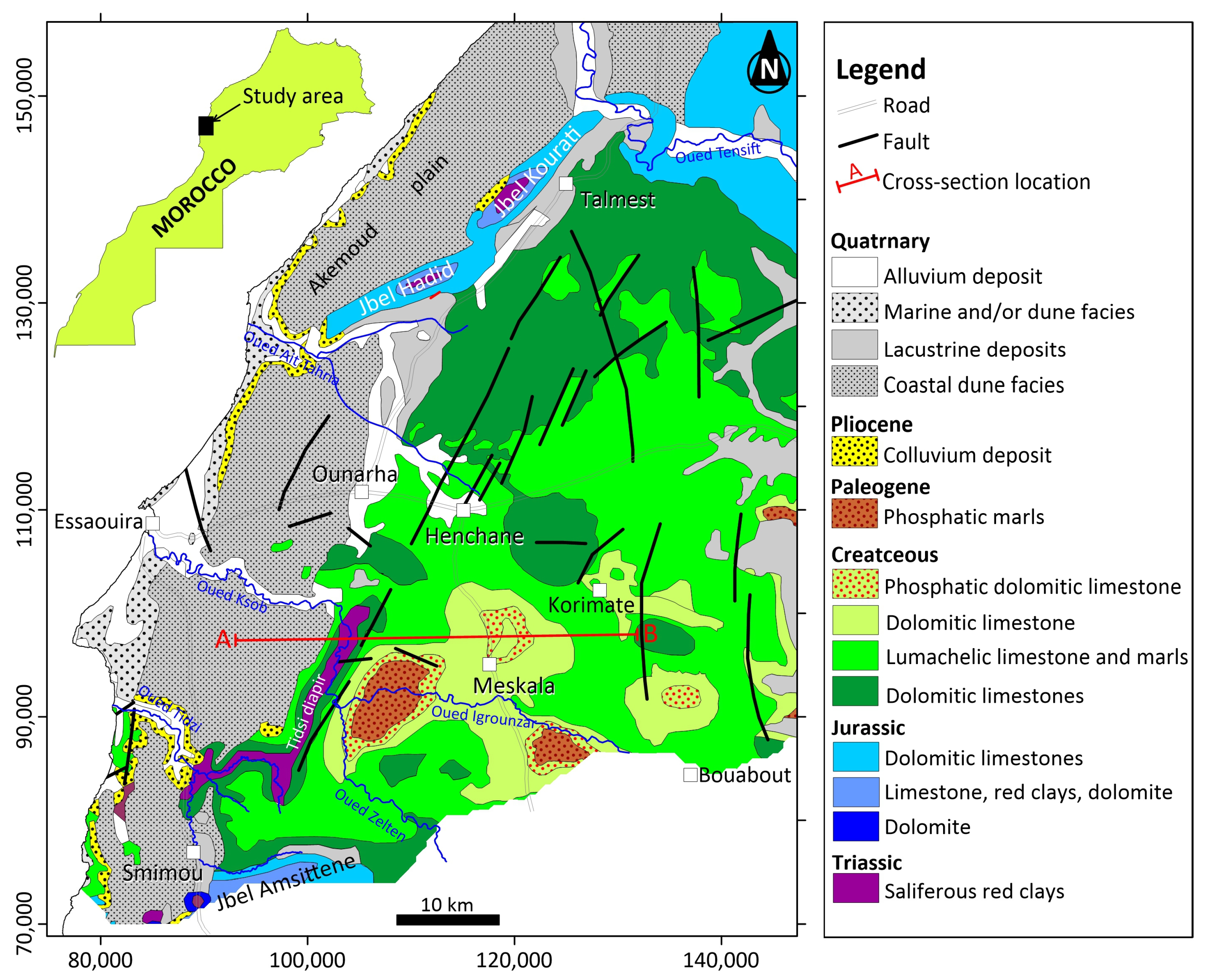
2. Geological and Structural Framework
- The Bouabout synclinal depression, crossed by the Oued Igrounzar
- The Ouled Bou Sbaa anticlinal ridge, which separates the Bouabout trough to the south from the Korimate syncline to the north.
- The Kourimate synclinal basin, where the sedimentary layers remain subhorizontal and are barely affected by a slight southward dip.
- The Essaouira synclinal basin, drained by the Oued Ksob.
- The Tidsi Permo-Triassic diapiric fault separating the Bouabout and Essaouira depressions. This fault is oriented E–W over a distance of 8 to 9 km along the Oued Tidsi, then NE–SW for 20 km until the north of the Oued Ksob.
- The saliferous anticlines of Jbel Hadid and Jbel Kourati
- The Akermoud coastal syncline, which extends to the ocean northwest of Jbel Hadid and Jbel Kourati.
3. Hydrogeological Framework
- The plio-quaternary reservoir, which is mainly composed of conglomerates with sandstone–limestone cement and sandy clay and silty deposits, ancient dunes, and sharp dunes. This ensemble lies on Cretaceous formations in the south and on Jurassic dolomites in the north. This aquifer contains perched aquifers.
- The Barremian reservoir, consisting of fractured sandstone and sandstone limestone, about 20 m thick.
- The Huterevian reservoir that is composed of sandstone and marl limestone and highly fractured sandstone, with an average thickness of 25 m.
4. Materials and Methods
4.1. Tilt Derivative or Tilt Angle
4.2. Improved Logistic Filter
4.3. Euler Deconvolution
5. Results and Discussion
- -
- Dry holes are systematically located outside of depressions inferred from the interpretation of the gravity data.
- -
- Productive holes are observed within these depressions and along or near faults, as structural discontinuities that act as groundwater pathways.
- -
- Some productive holes are also situated outside of the aforementioned depressions. These could correspond to wells or boreholes positioned in small sub-basins that could not be delineated by the gravity data used in this study due to their regional nature. The characterization of such localized troughs requires detailed investigations that could be carried out using a small-scale geophysical survey.
6. Conclusions
Author Contributions
Funding
Data Availability Statement
Acknowledgments
Conflicts of Interest
References
- Bahir, M.; Mennani, A.; Jalal, M.; Youbi, N. Ressources Hydriques Du Bassin Synclinal d’Essaouira (Maroc). Estud. Geol. 2000, 56, 185–195. [Google Scholar] [CrossRef]
- Chkir, N.; Trabelsi, R.; Bahir, M.; Hadj Ammar, F.; Zouari, K.; Chamchati, H.; Monteiro, J.P. Vulnérabilité Des Ressources En Eaux Des Aquifères Côtiers En Zones Semi-Arides–Etude Comparative Entre Les Bassins d’Essaouira (Maroc) et de La Jeffara (Tunisie). Comun. Geol. 2008, 95, 107–121. [Google Scholar]
- Archibald, N.; Gow, P.; Boschetti, F. Multiscale Edge Analysis of Potential Field Data. Explor. Geophys. 1999, 30, 38–44. [Google Scholar] [CrossRef]
- Jaffal, M.; Goumi, N.E.; Kchikach, A.; Aïfa, T.; Khattach, D.; Manar, A. Gravity and Magnetic Investigations in the Haouz Basin, Morocco. Interpretation and Mining Implications. J. Afr. Earth Sci. 2010, 58, 331–340. [Google Scholar] [CrossRef]
- Jaffal, M.; Charbaoui, A.; Kchikach, A.; El Ghorfi, M.; Khaldoun, A.; Safhi, A.E.M.; Bodinier, J.-L.; Yazami, O.K.; Jourani, E.-S.; Manar, A. Gravity Study of the Western Bahira Basin and the Gantour Phosphatic Plateau, Central Morocco: Interpretation and Hydrogeological Implications. J. Afr. Earth Sci. 2022, 193, 104581. [Google Scholar] [CrossRef]
- Maacha, L.; Jaffal, M.; Jarni, A.; Kchikach, A.; Mouguina, E.M.; Zouhair, M.; Ennaciri, A.; Saddiqi, O. A Contribution of Airborne Magnetic, Gamma Ray Spectrometric Data in Understanding the Structure of the Central Jebilet Hercynian Massif and Implications for Mining. J. Afr. Earth Sci. 2017, 134, 389–403. [Google Scholar] [CrossRef]
- Pham, B.T.; Tien Bui, D.; Prakash, I. Bagging Based Support Vector Machines for Spatial Prediction of Landslides. Environ. Earth Sci. 2018, 77, 146. [Google Scholar] [CrossRef]
- Pham, L.T.; Oksum, E.; Vu, M.D.; Vo, Q.T.; Du Le-Viet, K.; Eldosouky, A.M. An Improved Approach for Detecting Ridge Locations to Interpret the Potential Field Data for More Accurate Structural Mapping: A Case Study from Vredefort Dome Area (South Africa). J. Afr. Earth Sci. 2021, 175, 104099. [Google Scholar] [CrossRef]
- Pham, L.T.; Van Vu, T.; Le Thi, S.; Trinh, P.T. Enhancement of Potential Field Source Boundaries Using an Improved Logistic Filter. Pure Appl. Geophys. 2020, 177, 5237–5249. [Google Scholar] [CrossRef]
- Ouchchen, M.; Boutaleb, S.; Abia, E.H.; El Azzab, D.; Abioui, M.; Mickus, K.L.; Miftah, A.; Echogdali, F.Z.; Dadi, B. Airborne Magnetism of the Ighrem Region (Western Anti-Atlas, Morocco): Geological Interpretation and Prospecting of New Copper Zones. J. Afr. Earth Sci. 2021, 176, 104140. [Google Scholar] [CrossRef]
- Hollard, H.; Choubert, G.; Bronner, G.; Marchand, J.; Sougy, J. Carte géologique du Maroc à l’échelle 1/1,000,000. Notes et Mém. Serv. Géol. Maroc 1985, 260. [Google Scholar]
- Medina, F. Chronologie Des Phases et Style Tectonique Dans Le Haut Atlas Occidental, Maroc. Garcia Orta. Sér. Geol. 1985, 8, 43–54. [Google Scholar]
- Salvan, H.M. Les Formations Évaporitiques Du Trias Marocain. Problèmes Stratigraphiques, Paléogéographiques et Paléoclimatologiques. Quelques Réflexions. Rev. Géol. Dyn. Géogr. Phys. 1984, 25, 187–203. [Google Scholar]
- Broughton, P.; Trepanier, A. Hydrocarbon Generation in the Essaouira Basin of Western Morocco. AAPG Bull. 1993, 77, 999–1015. [Google Scholar]
- Hafid, M. Incidences de l’évolution Du Haut Atlas Occidental et de Son Avant Pays Septentrional Sur La Dynamique Mésocénozoïque de La Marge Atlantique (Entre Safi et Agadir). Apport de La Sismique Réflexion et Des Données de Forages. Ph.D. Thesis, Université Ibn Tofail, Kenitra, Morocco, 1999. Unpublished. [Google Scholar]
- Bouatmani, R.; Medina, F.; Salem, A.A.; Hoepffner, C. Thin-Skin Tectonics in the Essaouira Basin (Western High Atlas, Morocco): Evidence from Seismic Interpretation and Modelling. J. Afr. Earth Sci. 2003, 37, 25–34. [Google Scholar] [CrossRef]
- Medina, F.; Chorowicz, J. Phénomènes Synsédimentaires et Tectonique Extensive Mésozoïque: L’exemple de l’anticlinal d’Anklout Haut Atlas Occidental. Bull. L’institut Sci. (Rabat) 1983, 7, 23–32. [Google Scholar]
- Souid, A.K. Etude Tectonique et Microtectonique Des Injections Du Trias Du Bassin d’Essaouira Pendant Les Compressions Alpines Dans l’avant-Pays Atlantique (Maroc). Ph.D. Thesis, Université de Montpellier, Montpellier, France, 1983. [Google Scholar]
- Laville, E.; Petit, J.-P. Role of Synsedimentary Strike-Slip Faults in the Formation of Moroccan Triassic Basins. Geology 1984, 12, 424–427. [Google Scholar] [CrossRef]
- Medina, F. La Distension Triasique Contemporaine Du Rifting de l’Atlantique Central Dans Le Couloir d’Argana (Haut Atlas Occidental, Maroc). Bull. L’institut Sci. (Rabat) 1984, 39–46. [Google Scholar]
- Medina, F. Landsat Imagery Interpretation of Essaouira Basin (Morocco): Comparison with Geophysical Data, and Structural Implications. J. Afr. Earth Sci. (Middle East) 1989, 9, 69–75. [Google Scholar] [CrossRef]
- Piqué, A.; Laville, E. L’ouverture de l’Atlantique Central: Un Rejeu En Extension Des Structures Paléozoïques? In Comptes Rendus de L’Académie des Sciences. Série 2, Mécanique, Physique, Chimie, Sciences de L’univers, Sciences de la Terre; Gauthier-Villars: Paris, France, 1993; Volume 317, pp. 1325–1332. [Google Scholar]
- Pique, A.; Laville, E. L’ouverture Initiale de l’Atlantique Central. Bull. Soc. Géol. Fr. 1995, 166, 725–738. [Google Scholar]
- Le Roy, P.; Pique, A.; Le Gall, B.; Ait Brahim, L.; Morabet, A.M.; Demnati, A. Les Bassins Cotiers Triasico-Liasiques Du Maroc Occidental et La Diachronie Du Rifting Intra-Continental de l’Atlantique Central. Bull. Soc. Géol. Fr. 1997, 168, 637–648. [Google Scholar]
- Pique, A.; Ait Brahim, L.; Ait Ouali, R.; Amrhar, M.; Charroud, M.; Gourmelen, C.; Laville, E.; Rekhiss, F.; Tricart, P. Evolution Structurale Des Domaines Atlasiques Du Maghreb Au Méso-Cénozoïque; Le Rôle Des Structures Héritées Dans La Déformation Du Domaine Atlasique de l’Afrique Du Nord. Bull. Soc. Géol. Fr. 1998, 169, 797–810. [Google Scholar]
- Hanich, L. Structure et Fonctionnement d’un Aquifère Multicouche Carbonaté–Exemple Du Bassin d’Essaouira–Guide Méthodologique; Thesis report; Cadi Ayad University: Marrakech, Morocco, 2001. [Google Scholar]
- Taj-Eddine, K. Le Jurassique Terminal et Le Crétacé Basal Dans l’Atlas Atlantique (Maroc): Biostratigraphie, Sédimentologie, Stratigraphie Séquentielle et Géodynamique; Laboratoire de Géologie sédimentaire et Paléontologie, Université Paul Sabatier: Toulouse, France, 1992; Volume 16. [Google Scholar]
- Hanich, L.; Zouhri, L.; Dinger, J. Characterization of the Cretaceous Aquifer Structure of the Meskala Region of the Essaouira Basin, Morocco. J. Afr. Earth Sci. 2011, 59, 313–322. [Google Scholar] [CrossRef]
- Mehdi, K.; Griboulard, R.; Bobier, C. Rôle de l’halocinèse Dans l’évolution Du Bassin d’Essaouira (Sud-Ouest Marocain). C. R. Géosci. 2004, 336, 587–595. [Google Scholar] [CrossRef]
- Amrhar, M. Structural Evolution of the Western High Atlas in the Context of the Opening of the Central Atlantic and the Africa-Europe Collision. In Structure, Tectonic Instabilities and Neomagmatism; Cadi Ayad University: Marrakech, Morocco, 1995. [Google Scholar]
- Hafid, M. Triassic–Early Liassic Extensional Systems and Their Tertiary Inversion, Essaouira Basin (Morocco). Mar. Pet. Geol. 2000, 17, 409–429. [Google Scholar] [CrossRef]
- Bouatmani, R.; Chakor Alami, A.; Medina, F. Subsidence, Évolution Thermique et Maturation Des Hydrocarbures Dans Le Bassin d’Essaouira (Maroc): Apport de La Modélisation. Bull. L’institut Sci. Rabat 2007, 29, 15–36. [Google Scholar]
- Tari, G.; Novotny, B.; Jabour, H.; Hafid, M. Salt Tectonics along the Atlantic Margin of NW Africa (Morocco and Mauritania). In Permo-Triassic Salt Provinces of Europe, North Africa and the Atlantic Margins; Elsevier: Amsterdam, The Netherlands, 2017; pp. 331–351. [Google Scholar]
- Laftouhi, N.E. Hydrogéologie et Hydrogéochimie de l’aquifère Turonien Du Bassin Synclinal de Meskala-Kourimat-Ida Ou Zemzem (Essaouira, Maroc). Ph.D. Thesis, Cadi Ayad University, Marrakech, Morocco, 1991. [Google Scholar]
- Ben Kabbour, B. Contribution à l’identification et La Caractérisation d’un Système Aquifère Multicouche Par Méthodes Géophysiques, Hydrogéologiques et Télédétection. Exemple Appliqué à La Région d’Akermoud—Ain El Hjar (Province d’Essaouira, Maroc); University Cadi Ayyad: Marrakech, Maroc, 1995. [Google Scholar]
- Briggs, I.C. Machine Contouring Using Minimum Curvature. Geophysics 1974, 39, 39–48. [Google Scholar] [CrossRef]
- Everaerts, M.; Mansy, J.-L. Le Filtrage Des Anomalies Gravimetriques; Une Cle Pour La Comprehension Des Structures Tectoniques Du Boulonnais et de l’Artois (France). Bull. Soc. Géol. Fr. 2001, 172, 267–274. [Google Scholar] [CrossRef]
- Ouerghi, S.; Rebai, N.; Gabtni, H.; Farhat, B.; Bouaziz, S. Apport de La Gravimétrie à l’étude Des Structures Effondrées Du Nord-Est de La Tunisie: Implications Hydrogéologiques. Hydrol. Sci. J. 2013, 58, 1361–1373. [Google Scholar] [CrossRef]
- Khazri, D.; Gabtni, H. New Structural Model to Understanding the Subsurface Hydrogeology System of the Ouled Asker Groundwater, Central Tunisian Atlassic Foreland, Derived from an Integrated Geophysical Approach. Arab. J. Geosci. 2022, 15, 738. [Google Scholar] [CrossRef]
- Ikirri, M.; Jaffal, M.; Rezouki, I.; Echogdali, F.Z.; Boutaleb, S.; Abdelrahman, K.; Abu-Alam, T.; Faik, F.; Kchikach, A.; Abioui, M. Contribution of Gravity Data for Structural Characterization of the Ifni Inlier, Western Anti-Atlas, Morocco: Hydrogeological Implications. Appl. Sci. 2023, 13, 6002. [Google Scholar]
- Miller, H.G.; Singh, V. Potential Field Tilt—A New Concept for Location of Potential Field Sources. J. Appl. Geophys. 1994, 32, 213–217. [Google Scholar]
- Verduzco, B.; Fairhead, J.D.; Green, C.M.; MacKenzie, C. New Insights into Magnetic Derivatives for Structural Mapping. Lead. Edge 2004, 23, 116–119. [Google Scholar] [CrossRef]
- Salem, A.; Williams, S.; Fairhead, J.D.; Ravat, D.; Smith, R. Tilt-Depth Method: A Simple Depth Estimation Method Using First-Order Magnetic Derivatives. Lead. Edge 2007, 26, 1502–1505. [Google Scholar]
- Salem, A.; Williams, S.; Fairhead, D.; Smith, R.; Ravat, D. Interpretation of Magnetic Data Using Tilt-Angle Derivatives. Geophysics 2008, 73, L1–L10. [Google Scholar]
- Hood, P. Gradient Measurements in Aeromagnetic Surveying. Geophysics 1965, 30, 891–902. [Google Scholar] [CrossRef]
- Thompson, D.T. EULDPH: A New Technique for Making Computer-Assisted Depth Estimates from Magnetic Data. Geophysics 1982, 47, 31–37. [Google Scholar]
- Reid, A.B.; Allsop, J.M.; Granser, H.; Millett, A.; Somerton, I.W. Magnetic Interpretation in Three Dimensions Using Euler Deconvolution. Geophysics 1990, 55, 80–91. [Google Scholar] [CrossRef]
- Keating, P.B. Weighted Euler Deconvolution of Gravity Data. Geophysics 1998, 63, 1595–1603. [Google Scholar] [CrossRef]
- Mushayandebvu, M.F.; Lesur, V.; Reid, A.B.; Fairhead, J.D. Grid Euler Deconvolution with Constraints for 2D Structures. Geophysics 2004, 69, 489–496. [Google Scholar] [CrossRef]
- Shepherd, T.; Bamber, J.L.; Ferraccioli, F. Subglacial Geology in Coats Land, East Antarctica, Revealed by Airborne Magnetics and Radar Sounding. Earth Planet. Sci. Lett. 2006, 244, 323–335. [Google Scholar] [CrossRef]
- Keating, P.; Pilkington, M. Euler Deconvolution of the Analytic Signal and Its Application to Magnetic Interpretation. Geophys. Prospect. 2004, 52, 165–182. [Google Scholar] [CrossRef]
- Zakariah, M.N.A.; Roslan, N.; Sulaiman, N.; Lee, S.C.H.; Hamzah, U.; Noh, K.A.M.; Lestari, W. Gravity Analysis for Subsurface Characterization and Depth Estimation of Muda River Basin, Kedah, Peninsular Malaysia. Appl. Sci. 2021, 11, 6363. [Google Scholar] [CrossRef]
- Cooper, G.R.J. The Automatic Determination of the Location and Depth of Contacts and Dykes from Aeromagnetic Data. Pure Appl. Geophys. 2014, 171, 2417–2423. [Google Scholar] [CrossRef]
- Cordell, L.; Grauch, V.J.S. Mapping Basement Magnetization Zones from Aeromagnetic Data in the San Juan Basin, New Mexico. In The Utility of Regional Gravity and Magnetic Anomaly Maps; Society of Exploration Geophysicists: Houston, TX, USA, 1985; pp. 181–197. [Google Scholar]
- Barbosa, V.C.; Silva, J.B.; Medeiros, W.E. Stability Analysis and Improvement of Structural Index Estimation in Euler Deconvolution. Geophysics 1999, 64, 48–60. [Google Scholar] [CrossRef]
- Ugalde, H.; Morris, W.A. Cluster Analysis of Euler Deconvolution Solutions: New Filtering Techniques and Geologic Strike Determination. Geophysics 2010, 75, L61–L70. [Google Scholar] [CrossRef]
- Barbosa, V.C.; Silva, J.B. Reconstruction of Geologic Bodies in Depth Associated with a Sedimentary Basin Using Gravity and Magnetic Data. Geophys. Prospect. 2011, 59, 1021–1034. [Google Scholar] [CrossRef]
- Ravat, D. Analysis of the Euler Method and Its Applicability in Environmental Magnetic Investigations. J. Environ. Eng. Geophys. 1996, 1, 229–238. [Google Scholar] [CrossRef]
- FitzGerald, D.; Reid, A.; McInerney, P. New Discrimination Techniques for Euler Deconvolution. In Proceedings of the 8th SAGA Biennial Technical Meeting and Exhibition, Pilanesberg, South Africa, 7–10 October 2003. [Google Scholar]
- Reid, A.B. Euler Deconvolution: Past, Present and Future—A Review. In Proceedings of the 65th SEG meeting, Houston, USA, Expanded Abstracts, Houston, TX, USA, 8–13 October 1995; pp. 272–273. [Google Scholar]
- Hansen, R.O.; Suciu, L. Multiple-Source Euler Deconvolution. Geophysics 2002, 67, 525–535. [Google Scholar] [CrossRef]
- El Dawi, M.G.; Tianyou, L.; Hui, S.; Dapeng, L. Depth Estimation of 2-D Magnetic Anomalous Sources by Using Euler Deconvolution Method. Am. J. Appl. Sci. 2004, 1, 209–214. [Google Scholar] [CrossRef]
- Salem, A.; Smith, R. Depth and Structural Index from Normalized Local Wavenumber of 2D Magnetic Anomalies. Geophys. Prospect. 2005, 53, 83–89. [Google Scholar] [CrossRef]
- Melo, F.F.; Barbosa, V.C.; Uieda, L.; Oliveira, V.C.; Silva, J.B. Estimating the Nature and the Horizontal and Vertical Positions of 3D Magnetic Sources Using Euler Deconvolution. Geophysics 2013, 78, J87–J98. [Google Scholar] [CrossRef]
- Draper, N.R.; Smith, H. Applied Regression Analysis; John Wiley & Sons: Hoboken, NJ, USA, 1998; Volume 326. [Google Scholar]

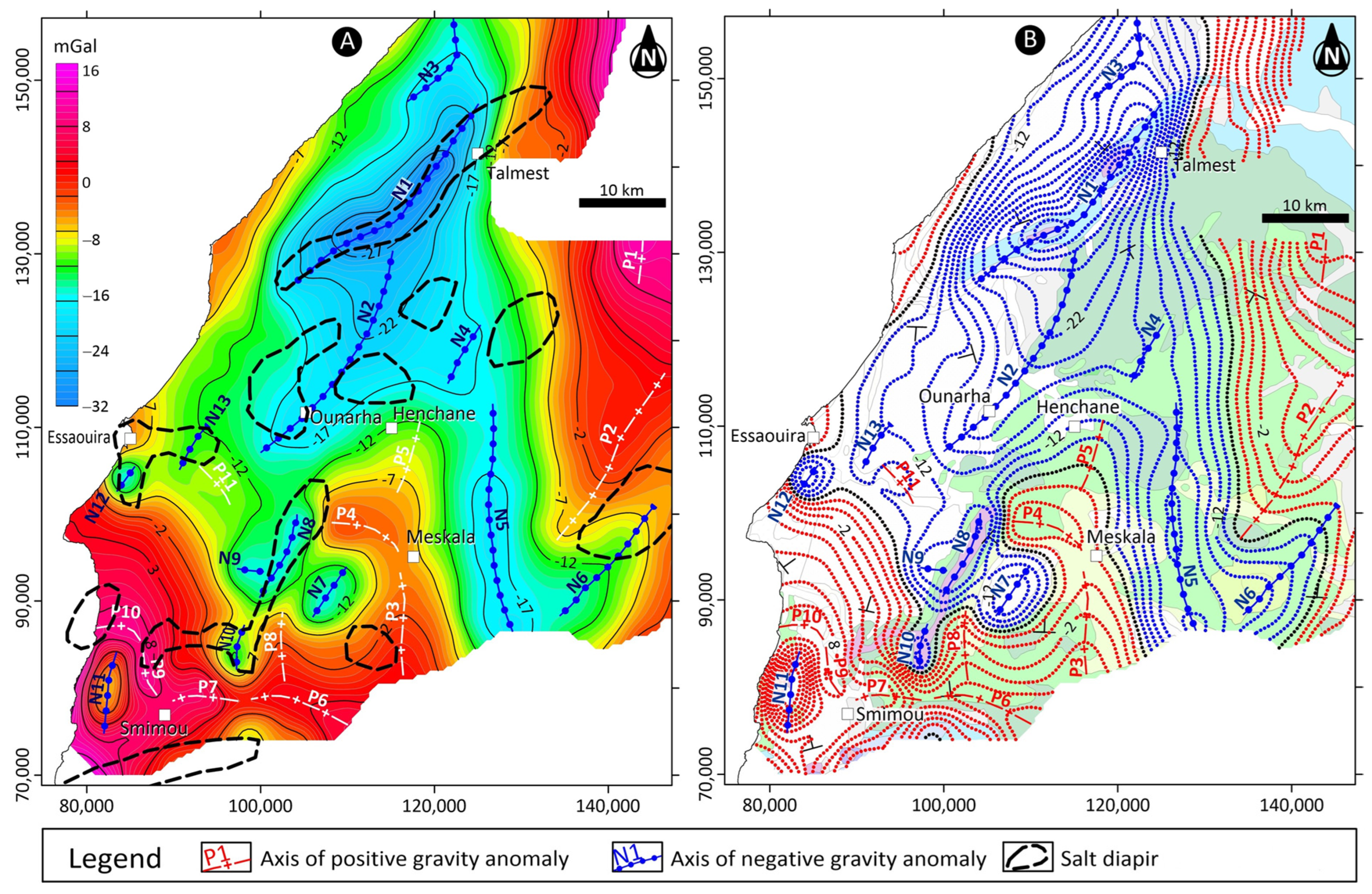

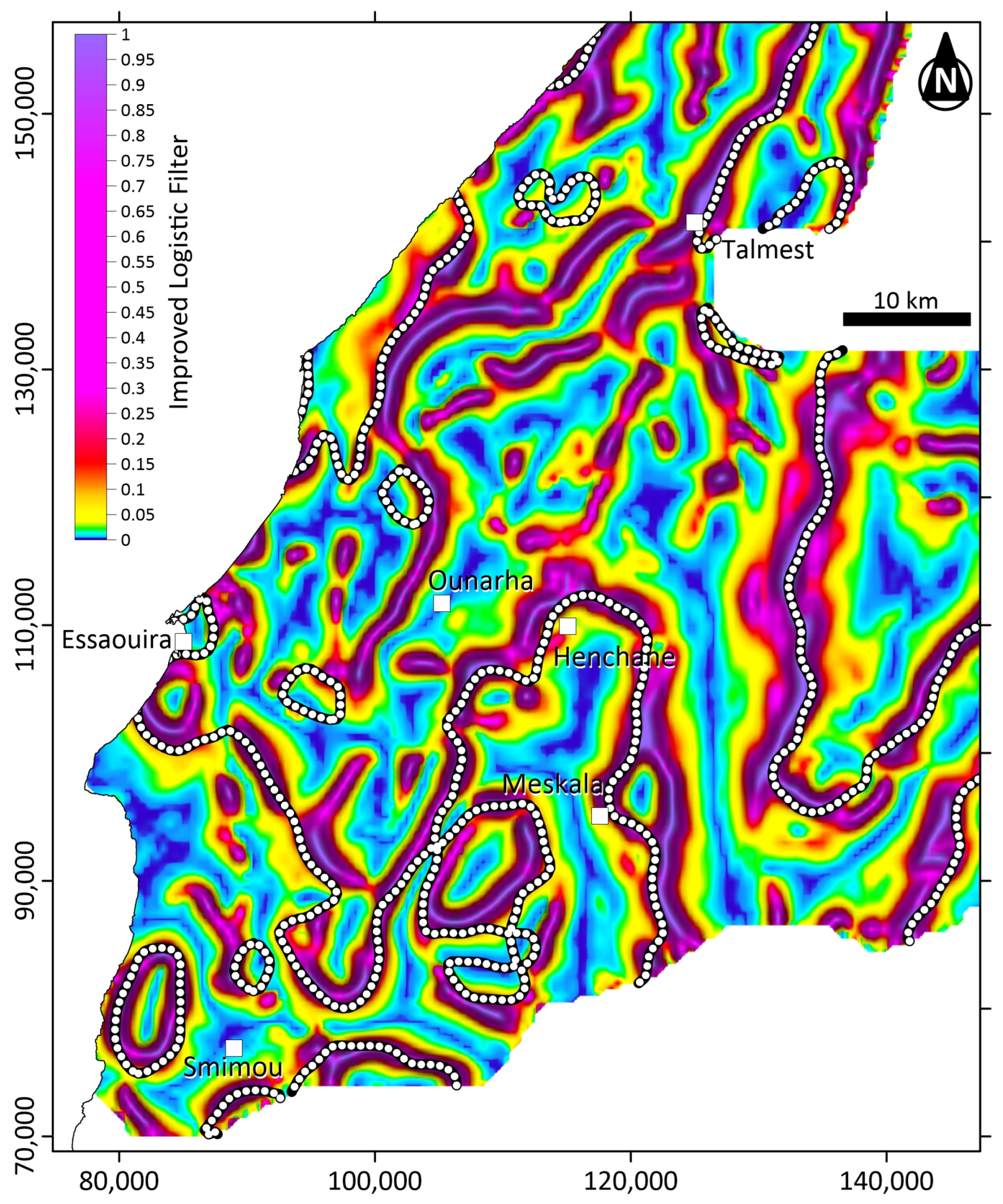
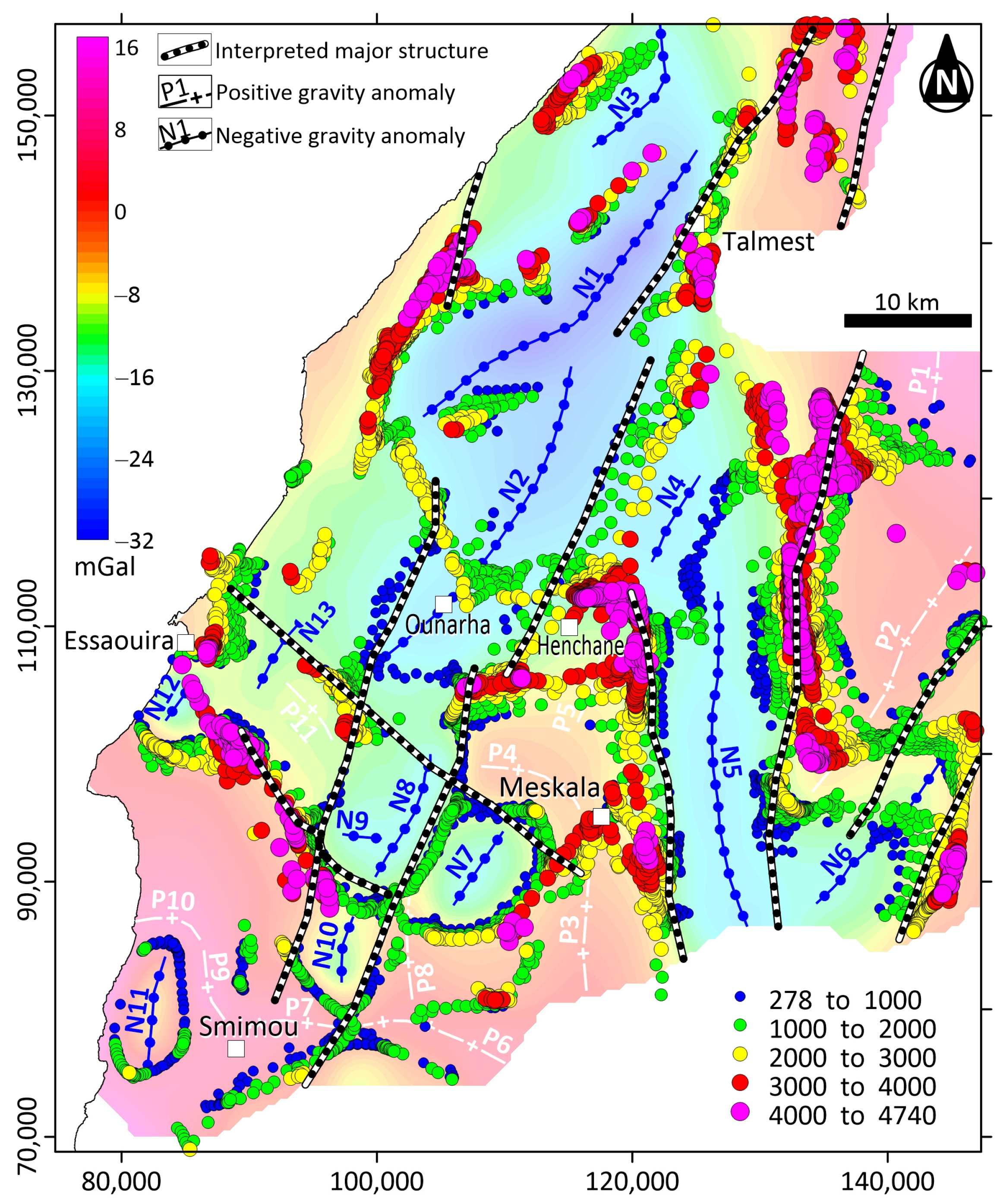
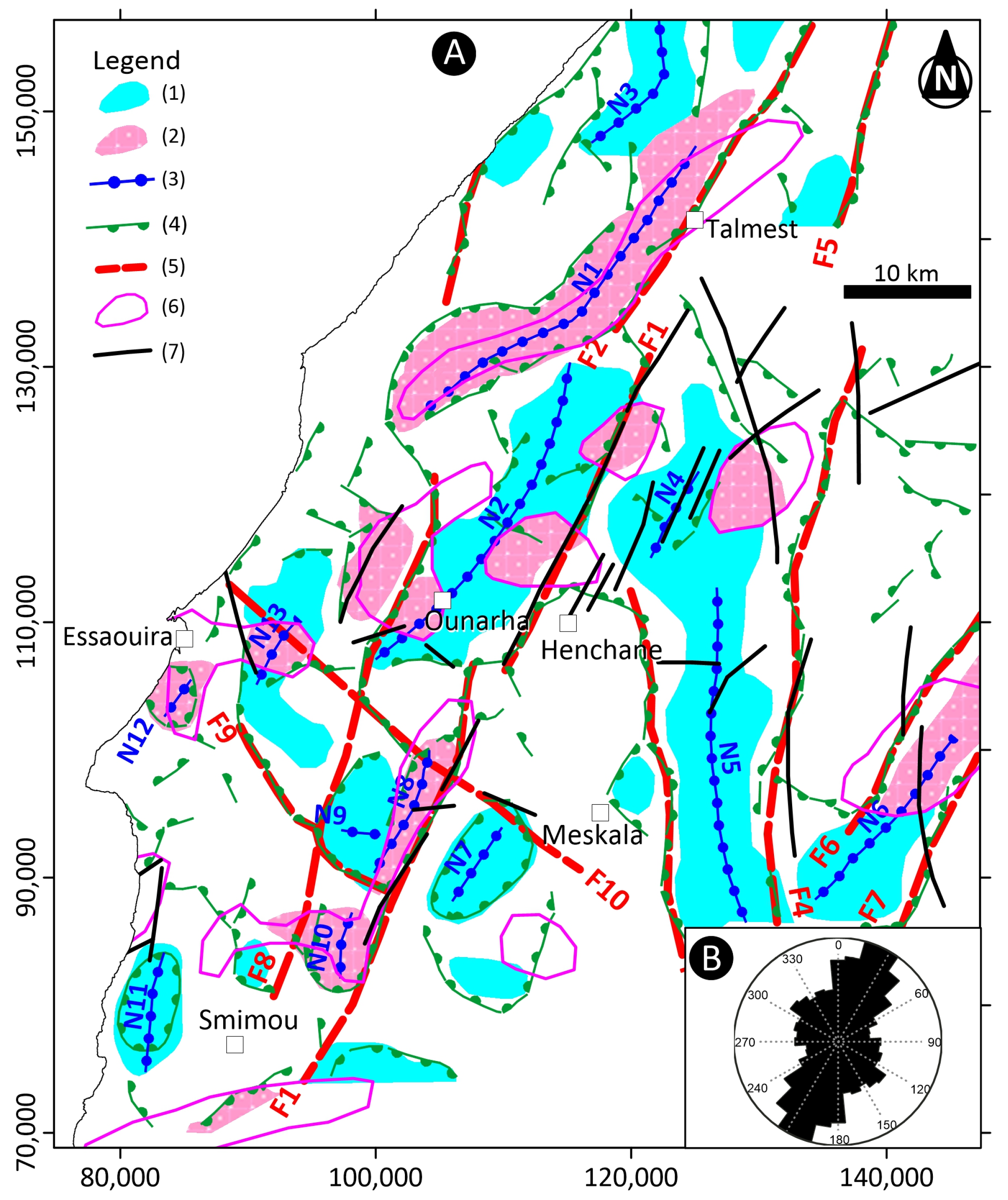
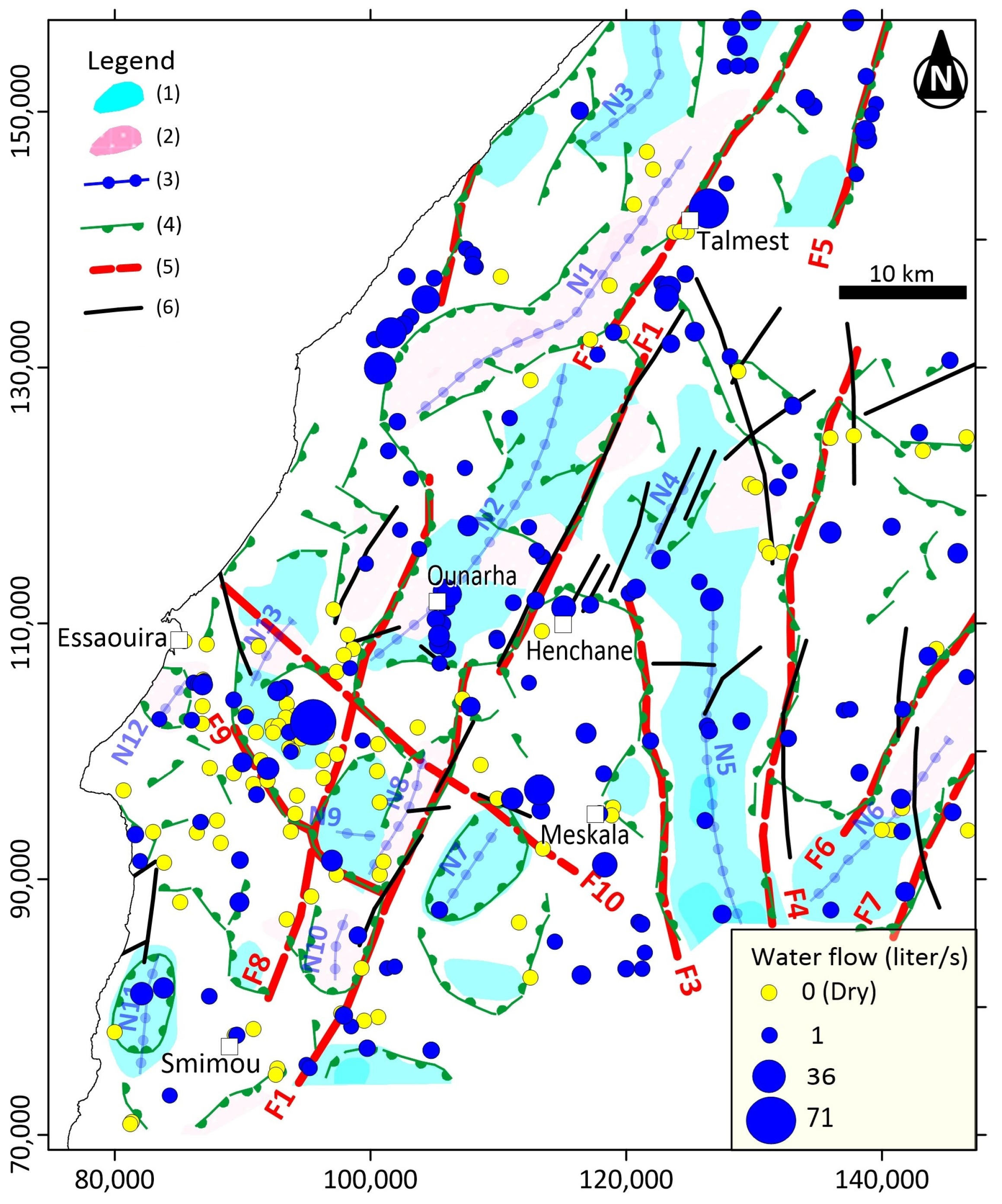
Disclaimer/Publisher’s Note: The statements, opinions and data contained in all publications are solely those of the individual author(s) and contributor(s) and not of MDPI and/or the editor(s). MDPI and/or the editor(s) disclaim responsibility for any injury to people or property resulting from any ideas, methods, instructions or products referred to in the content. |
© 2023 by the authors. Licensee MDPI, Basel, Switzerland. This article is an open access article distributed under the terms and conditions of the Creative Commons Attribution (CC BY) license (https://creativecommons.org/licenses/by/4.0/).
Share and Cite
Khouz, A.; Jaffal, M.; Trindade, J.; Bougadir, B.; El Bchari, F.; Kchikach, A.; El Ghorfi, M.; Ibouh, H.; Jadoud, M.; Kadiri, O.; et al. Understanding the Deep Structure of the Essaouira Basin Using Gravity Data: Hydrogeological Inferences for a Semiarid Region in Central-Western Morocco. Geosciences 2023, 13, 345. https://doi.org/10.3390/geosciences13110345
Khouz A, Jaffal M, Trindade J, Bougadir B, El Bchari F, Kchikach A, El Ghorfi M, Ibouh H, Jadoud M, Kadiri O, et al. Understanding the Deep Structure of the Essaouira Basin Using Gravity Data: Hydrogeological Inferences for a Semiarid Region in Central-Western Morocco. Geosciences. 2023; 13(11):345. https://doi.org/10.3390/geosciences13110345
Chicago/Turabian StyleKhouz, Abdellah, Mohammed Jaffal, Jorge Trindade, Blaid Bougadir, Fatima El Bchari, Azzouz Kchikach, Mustapha El Ghorfi, Hassan Ibouh, Mourad Jadoud, Omar Kadiri, and et al. 2023. "Understanding the Deep Structure of the Essaouira Basin Using Gravity Data: Hydrogeological Inferences for a Semiarid Region in Central-Western Morocco" Geosciences 13, no. 11: 345. https://doi.org/10.3390/geosciences13110345






